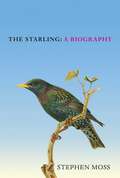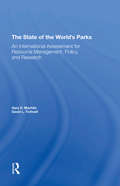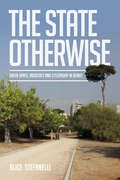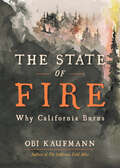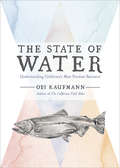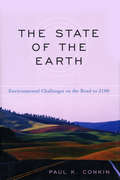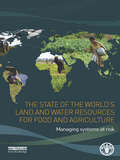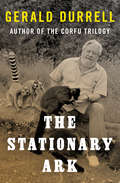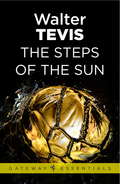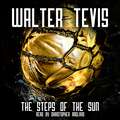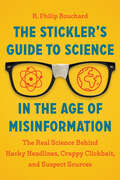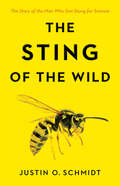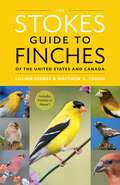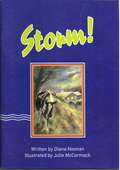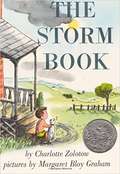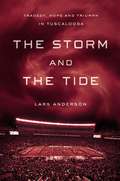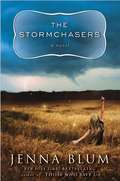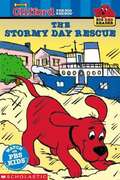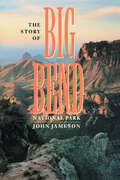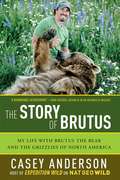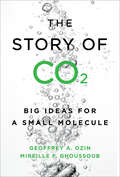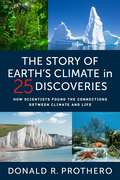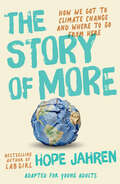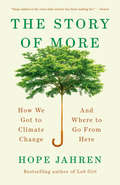- Table View
- List View
The Starling: The perfect Christmas gift for bird lovers (The Bird Biography Series)
by Stephen Moss‘Stephen Moss delights once more - lyrical and informative by turns, he conjures - with breathless eloquence - another feathered beauty of our skies.’ Benedict Allen'An engrossing compilation of ornithological tidbits, cultural anecdotes, literary quotes and well chosen historical artwork’ BBC Wildlife, *Books of the Year*Uncover the life of starlings through this beautiful guide to these majestic and gregarious birds from the bestselling author of The Owl, The Robin, The Wren, and The Swan. Even with its exquisite iridescent plumage and magical gift to mimic both human and natural sounds, this common garden bird can often be overlooked. But as they unite in their thousands to display their unique ability to perform dazzling aerial manoeuvres known as murmurations, starlings are nothing short of breathtaking. This is the captivating story of how starlings have shaped our world, from influencing agriculture and inspiring musicians such as Mozart and writers such as Shakespeare, to their impact as an invasive species in North America, South Africa, Australia and New Zealand.With beautiful illustrations throughout, and an expert guide to the most magnificent murmurations in the UK, this eye-opening biography reveals the hidden secrets of one of our most talented and luminous birds.
The State Of The World's Parks: An International Assessment For Resource Management, Policy, And Research
by Gary E Machlis David L. TichnellNational parks are a global phenomenon found in more than 120 countries. These parks are as diverse as the physical settings and cultural patterns of the many nations that have established them, yet within each country they serve as part of the cohesiveness that binds people together. Parks reflect-and help create-people's pride and love for their national heritage.
The State Otherwise: Green Space, Citizenship and Advocating for the Public in Beirut
by Alice StefanelliThe city of Beirut is increasingly congested, polluted and suffocating. Its already limited green public spaces are under growing threat of privatisation and redevelopment. The State Otherwise examines the difficult predicament of Beirut’s public green spaces from the vantage point of the civic campaign to reopen Horsh al Sanawbar, the city’s largest public park. Analysing the relationship between neoliberal sectarianism, private interest and political action, the book asks questions about the nature of privatisation of public property, civic society’s potential to mobilise individuals and the role of public authorities in promoting the public good.
The State of Fire: Why California Burns
by Obi KaufmannHow do we live with fire? From the creator of The California Field Atlas, a book of stewardship, resilience, and hope.Fire is an essential part of California's ecology. Humans have been using it to shape the California landscape for thousands of years. But today many Californians' relationship to fire is one of fear. Obi Kaufmann, author of the best-selling California Field Atlas, now asks: How do we live with fire? What makes fire essential to a healthy and biodiverse Golden State, and how do we benefit from its teachings? With the same solution-minded ethic as his much-admired The State of Water: Understanding California's Most Precious Resource, Kaufmann presents fire as a force of regeneration rather than apocalypse. He considers the long history of ecological burns, the varied ways fire behaves across the state, and the lessons we can learn from California's largest fires of recent decades.Packed with Kaufmann's signature watercolor maps and paintings, The State of Fire confronts one of California's most pressing social and ecological challenges. From this maelstrom Kaufmann emerges to share a deepened love for the natural world—and a refreshingly hopeful vision of California's future.
The State of Water: Understanding California's Most Precious Resource
by Obi KaufmannObi Kaufmann, author of the best-selling California Field Atlas, turns his artful yet analytical attention to the Golden State's single most complex and controversial resource: water. In this new book, full-color maps unravel the braided knot of California's water infrastructure and ecosystems, exposing a history of unlimited growth in spite of finite natural resources—a history that has led to its current precarious circumstances. Yet this built world depends upon the biosphere, and in The State of Water Kaufmann argues that environmental conservation and restoration efforts are necessary not only for ethical reasons but also as a matter of human survival. Offering nine perspectives to illustrate the most pressing challenges facing California's water infrastructure, from dams to species revitalization, Kaufmann reveals pragmatic yet inspiring solutions to how water in the West can continue to support agriculture, municipalities, and the environment. Interspersed throughout with trail paintings of animals that might yet survive under a caring and careful water ethic, Kaufmann shows how California can usher in a new era of responsible water conservation, and—perhaps most importantly—how we may do so together.
The State of the Earth: Environmental Challenges on the Road to 2100
by Paul K. ConkinAn assessment of where we are, where we&’re headed, and what we need to do before it&’s too late: &“Instructive, well-researched, and easy-to-read.&” —John T. Ackerman, Strategic Studies Quarterly This era of staggering scientific and technological innovations, with major changes in agriculture, manufacturing, commerce, and communications, seems to document unparalleled human achievement. Yet when we examine the long-term implications, it becomes clear that the delicate environmental balance that sustains life on this planet is under serious threat, and the past century may be remembered not as a period of great progress but as one marked by unrestrained consumption and failure to come close to a sustainable use of the earth&’s limited natural resources. In The State of the Earth, noted historian Paul K. Conkin provides a comprehensive analysis of the many environmental hazards that humans must face in this still-young century. Our activities have threatened the survival of many plants and animals, created scarcities in cultivatable soils and water needed for irrigation, used up a large share of fossil fuels, polluted air and water, and most likely created conditions that will lead to devastating climate changes. This is an invaluable resource for those who desire a broad yet thorough and scientifically informed introduction to present environmental challenges.
The State of the World's Land and Water Resources for Food and Agriculture: Managing Systems at Risk
by Food and of the United NationsThe State of the World's Land and Water Resources for Food and Agriculture is FAO's first flagship publication on the global status of land and water resources. It is an 'advocacy' report, to be published every three to five years, and targeted at senior level decision makers in agriculture as well as in other sectors. SOLAW is aimed at sensitizing its target audience on the status of land resources at global and regional levels and FAO's viewpoint on appropriate recommendations for policy formulation. SOLAW focuses on these key dimensions of analysis: (i) quantity, quality of land and water resources, (ii) the rate of use and sustainable management of these resources in the context of relevant socio-economic driving factors and concerns, including food security and poverty, and climate change. This is the first time that a global, baseline status report on land and water resources has been made. It is based on several global spatial databases (e.g. land suitability for agriculture, land use and management, land and water degradation and depletion) for which FAO is the world-recognized data source. Topical and emerging issues on land and water are dealt with in an integrated rather than sectoral manner. The implications of the status and trends are used to advocate remedial interventions which are tailored to major farming systems within different geographic regions.
The Stationary Ark (El\libro De Bolsillo Ser.)
by Gerald DurrellA famed zookeeper reflects on his lifelong love of animals—and his decision to build them a home—in this memoir by the author of the Corfu Trilogy. The first word Gerald Durrell could say with any clarity was &“zoo.&” Animals were his passion. His early years in India were full of routine visits to the local zoo, and if his nursemaid attempted to deviate from this routine, the result was usually a tantrum. Years later, when Durrell decided to set up the Jersey Wildlife Preservation Trust—which would later become the Durrell Wildlife Conservation Trust—he didn&’t want it to be like other zoos. He didn&’t want a place where animals were simply imprisoned, where parents reluctantly brought their children to get sick on ice cream. More than a place for entertainment, Durrell&’s zoo needed to be a place for education, research, and conservation. But achieving his goal would force him to question if wild animals really did belong in the care of humans. The Stationary Ark is an entertaining and thoughtful look at a career in zookeeping from the man who inspired acclaimed Masterpiece production The Durrells in Corfu, which aired on public television. This ebook features an illustrated biography of Gerald Durrell including rare photos from the author&’s estate.
The Steps of the Sun: From the author of The Queen's Gambit – now a major Netflix drama (Gateway Essentials #510)
by Walter TevisA science fiction thriller from the author of THE MAN WHO FELL TO EARTH.'A fine engrossing novel by a master!' Philadelphia EnquirerIn a time when America's power has been eroded by energy depletion, and world control has been virtually given over to the Chinese, only one man has the courage to seek new mineral resources among the stars. He is Ben Belson, one of the richest men in the world, a man haunted by the memory of a loveless childhood and driven by needs and desires he can barely understand or control. His dream is to find the means to help America break the stranglehold of the corrupt interests who are keeping it a second class power.
The Steps of the Sun: From the author of The Queen's Gambit – now a major Netflix drama (Gateway Essentials #510)
by Walter TevisA science fiction thriller from the author of THE MAN WHO FELL TO EARTH.'A fine engrossing novel by a master!' Philadelphia EnquirerIn a time when America's power has been eroded by energy depletion, and world control has been virtually given over to the Chinese, only one man has the courage to seek new mineral resources among the stars. He is Ben Belson, one of the richest men in the world, a man haunted by the memory of a loveless childhood and driven by needs and desires he can barely understand or control. His dream is to find the means to help America break the stranglehold of the corrupt interests who are keeping it a second class power.
The Stickler's Guide to Science in the Age of Misinformation: The Real Science Behind Hacky Headlines, Crappy Clickbait, and Suspect Sources
by R. Philip BouchardThe Real Science Behind Hacky Headlines, Crappy Clickbait, and Suspect SourcesWe have more scientific information at our fingertips today than ever before. And more disinformation too. Online, on television, and in print, science is often communicated through shorthand analogies and phrases that obscure or omit important facts. &“Superfoods,&” &“right- and left-brained&” people, and &“global warming&” may be snappy and ear-catching but are they backed by scientific facts? Lifelong educator R. Philip Bouchard is a stickler for this kind of thing, and he is well-prepared to set the record straight.The Stickler&’s Guide to Science in the Age of Misinformation unpacks the many misuses of terms we see used every day, revealing how these popular &“scientific&” concepts fall short of real science. Find out why trees do not &“store&” carbon dioxide; a day is not actually 24 hours; DNA cannot provide a &“blueprint&” for a human being; and an absence of gravity is not the reason that astronauts float in space.With The Stickler&’s Guide to Science in the Age of Misinformation, Bouchard makes hard science go down easy, satisfying curiosity and sparking further inquiry that will keep you from getting fooled again.
The Sting of the Wild
by Justin O. SchmidtThe "King of Sting" describes his adventures with insects and the pain scale that’s made him a scientific celebrity.Silver, Science (Adult Non-Fiction) Foreword INDIES Award 2017Entomologist Justin O. Schmidt is on a mission. Some say it’s a brave exploration, others shake their heads in disbelief. His goal? To compare the impacts of stinging insects on humans, mainly using himself as the test case.In The Sting of the Wild, the colorful Dr. Schmidt takes us on a journey inside the lives of stinging insects. He explains how and why they attack and reveals the powerful punch they can deliver with a small venom gland and a "sting," the name for the apparatus that delivers the venom. We learn which insects are the worst to encounter and why some are barely worth considering. The Sting of the Wild includes the complete Schmidt Sting Pain Index, published here for the first time. In addition to a numerical ranking of the agony of each of the eighty-three stings he’s sampled so far, Schmidt describes them in prose worthy of a professional wine critic: "Looks deceive. Rich and full-bodied in appearance, but flavorless" and "Pure, intense, brilliant pain. Like walking over flaming charcoal with a three-inch nail embedded in your heel."Schmidt explains that, for some insects, stinging is used for hunting: small wasps, for example, can paralyze huge caterpillars for long enough to lay eggs inside them, so that their larvae emerge within a living feast. Others are used to kill competing insects, even members of their own species. Humans usually experience stings as defensive maneuvers used by insects to protect their nest mates. With colorful descriptions of each venom’s sensation and a story that leaves you tingling with awe, The Sting of the Wild’s one-of-a-kind style will fire your imagination.
The Stokes Guide to Finches of the United States and Canada
by Lillian Q. Stokes Matthew A. YoungLearn all you need to know about identifying and attracting finches with this comprehensive, gloriously colorful field guide from America&’s foremost authorities on birds and nature. Following the extraordinary finch superflight of 2020-2021, birders across the country became obsessed with finches. With The Stokes Guide to Finches of the United States and Canada, you can gain expert knowledge on these beautiful birds and bring them into your own yard. This fully illustrated guide tells you all you need to know about attracting, observing, and protecting finches. The book also includes: A special section on endangered Hawaiian honeycreeper finches, plus other rare and vagrant species Detailed identification information on each finch species&’ plumages, subspecies, and voice The most complete and up-to-date range maps, including maps of core occurrence and irruption ranges for all red crossbill call types, which have never before been published in a guide Complete life history information Scientific studies on finch migrations and conservation More than 345 stunning full-color photographs and over 50 range maps covering 43 species
The Storm Book
by Charlotte ZolotowIt is a day in the country, and everything is hot and still. Then the hazy sky begins to shift. Something is astir, something soundless.
The Storm and the Tide: Tragedy, Hope and Triumph in Tuscaloosa
by Lars AndersonThe moving story of how a shared tragedy inspired a college football dynasty. On April 27, 2011, a powerful tornado ripped through the heart of Tuscaloosa, Ala., leaving 53 dead and a path of unimaginable devastation. In the aftermath, Alabama coach Nick Saban and his football team went out into the community, sharing its grief and aiding in the recovery. Together they forged an unbreakable bond, and in a place where Saturdays are dedicated to Crimson Tide football, "Let's play for Tuscaloosa" became a rallying cry, an emotional touchstone that transcended the playing field. Barrett Jones, a 300-pound tackle, went street by street with a chain saw clearing debris. Long snapper Carson Tinker, who endured terrible personal tragedy in the storm, emerged as the public face of Tuscaloosa's resilience. Diehard fans Bob and Dana Dowling lost their home but saw a new one raised by the muscle of Crimson Tide players. The rebuilding effort became a heartfelt crusade; the football team was now competing for a cause much greater than a national championship. In The Storm and the Tide, Lars Anderson chronicles the rise of a team, the building of a dynasty and the resurgence of a town.
The Storm and the Tide: Tragedy, Hope and Triumph in Tuscaloosa
by Lars AndersonTHE MOVING STORY OF HOW A SHARED TRAGEDY INSPIRED A COLLEGE FOOTBALL DYNASTY On April 27, 2011, a powerful tornado ripped through the heart of Tuscaloosa, Ala. , leaving 53 dead and a path of unimaginable devastation. In the aftermath, Alabama coach Nick Saban and his football team went out into the community, sharing its grief and aiding in the recovery. Together they forged an unbreakable bond, and in a place where Saturdays are dedicated to Crimson Tide football, "Let's play for Tuscaloosa" became a rallying cry, an emotional touchstone that transcended the playing field. Barrett Jones, a 300-pound tackle, went street by street with a chain saw clearing debris. Long snapper Carson Tinker, who endured terrible personal tragedy in the storm, emerged as the public face of Tuscaloosa's resilience. Diehard fans Bob and Dana Dowling lost their home but saw a new one raised by the muscle of Crimson Tide players. The rebuilding effort became a heartfelt crusade; the football team was now competing for a cause much greater than a national championship. In The Storm and the Tide, Lars Anderson chronicles the rise of a team, the building of a dynasty and the resurgence of a town.
The Stormchasers
by Jenna BlumTwins are forced to confront a violent secret from their past in Jenna Blum's first novel since her runaway bestseller, Those Who Save Us. How far would you go to protect a sibling - and at what cost to yourself? In Those Who Save Us, Jenna Blum proved herself a master storyteller with brilliant insight into the spectrum of human emotion. Now, Blum turns her sights to the most intimate and mysterious of family relationships - that between twins - in her powerful and provocative second novel. As a teenager, Karena Jorge had always been the one to look out for her twin brother Charles, who suffers from bipolar disorder. But as Charles begins to refuse medication and his manic tendencies worsen, Karena finds herself caught between her loyalty to her brother and her fear for his life. Always obsessed with the weather - enraptured by its magical unpredictability that seemed to mirror his own impulses - Charles starts chasing storms, and his behavior grows increasingly erratic. . . until a terrifying storm chase with Karena ends with deadly consequences, tearing the twins apart and changing both of their lives forever. Two decades later, Karena gets a call from a psychiatric ward in Wichita, Kansas, to come pick up her brother, whom she hasn't seen or spoken to for twenty years. She soon discovers that Charles has lied to the doctors, taken medication that could make him dangerously manic, and disappeared again. Having exhausted every resource to try and track him down, Karena realizes she has only one last chance of finding him: the storms. Wherever the tornadoes are, that's where he'll be. Karena joins a team of professional stormchasers - passionate adventurers who will transform her life and give her a chance at love and redemption - and embarks on an odyssey to find her brother before he reveals the violent secret from their past and does more damage to himself. . . or to someone else.
The Stormy Day Rescue
by Norman Bridwell Kimberly WeinbergerClifford is in trouble all over town for his digging, but when a storm threatens the library, he may be the only one who can save it.
The Story of Big Bend National Park
by John JamesonThe history of the first national park in Texas—the politics, intrigues, controversies, and the people inspired by the stunning desert environment. A breathtaking country of rugged mountain peaks, uninhabited desert, and spectacular river canyons, Big Bend is one of the United States&’ most remote national parks and among Texas&’ most popular tourist attractions. Located in the great bend of the Rio Grande that separates Texas and Mexico, the park comprises some 800,000 acres, an area larger than the state of Rhode Island, and draws over 300,000 visitors each year. The Story of Big Bend National Park offers a comprehensive, highly readable history of the park from before its founding in 1944 up to the present. John Jameson opens with a fascinating look at the mighty efforts involved in persuading Washington officials and local landowners that such a park was needed. He details how money was raised and land acquired, as well as how the park was publicized and developed for visitors. Moving into the present, he discusses such issues as natural resource management, predator protection in the park, and challenges to land, water, and air. Along the way, he paints colorful portraits of many individuals, from area residents to park rangers to Lady Bird Johnson, whose 1966 float trip down the Rio Grande brought the park to national attention. This history will be required reading for all visitors and prospective visitors to Big Bend National Park. For everyone concerned about our national parks, it makes a persuasive case for continued funding and wise stewardship of the parks as they face the twin pressures of skyrocketing attendance and declining budgets.
The Story of Brutus: My Life with Brutus the Bear and the Grizzlies of North America
by Casey AndersonThe heart-warming story of the incredible friendship between National Geographic star Casey Anderson and an 800-pound grizzly bear named Brutus. Casey Anderson, the host of National Geographic's Expedition Grizzly, met a month-old bear cub in a wildlife preserve in 2002, whom he affectionately named Brutus. Little Brutus was destined to remain in captivity or, more likely, even euthanized due to overpopulation at the preserve. Anderson, already an expert in animal rescue and rehabilitation, just could not let that happen to Brutus, who looked like a "fuzzy Twinkie." From the beginning it was clear something special existed between the two. And so, Anderson built the Montana grizzly encounter in Bozeman, Montana, especially for Brutus, so that he, and others like him, could grow up "being a bear." And so the love story began. When together, Anderson and Brutus will wrestle, swim, play, and continue to act as advocates for grizzly protection and education, be it through documentaries like Expedition Grizzly, appearances on Oprah or Good Morning America, or in this inspiring book, which promises to be an intimate look into Anderson's relationship with Brutus and a call to action to protect these glorious animals and the natural world they live in. The Story of Brutus proves that love and friendship knows no bounds and that every care must be taken to protect one of nature's noblest creatures.
The Story of CO2: Big Ideas for a Small Molecule
by Geoffrey Ozin Mireille GhoussoubThe climate crisis requires that we drastically reduce carbon dioxide emissions across all sectors of society. The Story of CO2 contributes to this vital conversation by highlighting the cutting-edge science and emerging technologies – a number of which are already commercially available – that can transform carbon dioxide into a myriad of products such as feedstock chemicals, polymers, pharmaceuticals, and fuels. This approach allows us to reconsider CO2 as a resource, and to add "carbon capture and use" to our other tools in the fight against catastrophic climate change. The Story of CO2 explores all aspects of carbon dioxide, from the atomic to the universal perspective, and takes the reader on an epic journey into our physical world, starting from the moment of the Big Bang, all the way to the present world in which atmospheric CO2 concentrations continue to grow. This story seeks to inspire readers with the latest carbon utilization technologies and explain how they fit within the broader context of carbon mitigation strategies in the shift towards a sustainable energy economy.
The Story of Earth's Climate in 25 Discoveries: How Scientists Found the Connections Between Climate and Life
by Donald R. ProtheroOver 4.5 billion years, Earth’s climate has transformed tremendously. Before our more temperate recent past, the planet swung from one extreme to another—from a greenhouse world of sweltering temperatures and high sea levels to a “snowball earth” in which glaciers reached the equator. During this history, we now know, living things and the climate have always influenced and even shaped each other. But the climate has never changed as rapidly or as drastically as it has since the Industrial Revolution.In this lively and entertaining book, Donald R. Prothero explores the astonishing connections between climate and life through the ages, telling the remarkable stories of the scientists who made crucial discoveries. Journeying through the intertwined evolution of climate and life, he tackles questions such as: Why do we have phytoplankton to thank for the air we breathe? What kind of climate was necessary for the rise of the dinosaurs—or the mammals, their successors? When and how have climatic changes caused mass extinctions? Prothero concludes with the Ice Ages and the Holocene, the role of climate in human history, and the perils of anthropogenic climate change. Understanding why the climate has changed in the past, this timely book shows, is essential to grasping the gravity of how radically human activity is altering the climate today.
The Story of More (Adapted for Young Adults): How We Got to Climate Change and Where to Go from Here
by Hope JahrenThis young adult adaptation of acclaimed geochemist and geobiologist Hope Jahren's highly respected nonfiction work is the perfect book for those interested in learning about climate change and how they can contribute to creating a more sustainable future.Hope Jahren, acclaimed geochemist and geobiologist, details the science behind key inventions, clarifying how electricity, large-scale farming, and automobiles have both helped and harmed our world. Jahren explains the current and projected consequences of unchecked global warming, from superstorms to rising sea levels, resulting from the unprecedented amounts of greenhouse gases being released into our atmosphere. The links between human consumption habits and our endangered existence are very real, with consequences leading to a crossroads of survival and extinction. Still, Jahren maintains that our ever-broadening science-based knowledge can help us counter this dilemma. The eye-opening information provided in The Story of More will help readers understand the path we must take. If we collectively make informed choices now, Jahren reassures us, our future can be as bright as we imagine it can be.
The Story of More: How We Got to Climate Change and Where to Go from Here
by Hope JahrenFrom the bestselling author of Lab Girl comes a slim, urgent missive on the defining issue of our time: here is Hope Jahren on climate change, our timeless pursuit of more, and how the same human ambition that got us here can also be our salvation.Hope Jahren is an award-winning geobiologist, a brilliant writer, and one of the seven billion people with whom we share this earth. The Story of More is her impassioned open letter to humanity as we stand at the crossroads of survival and extinction. Jahren celebrates the long history of our enterprising spirit--which has tamed wild crops, cured diseases, and sent us to the moon--but also shows how that spirit has created excesses that are quickly warming our planet to dangerous levels. In short, highly readable chapters, she takes us through the science behind the key inventions--from electric power to large-scale farming and automobiles--that, even as they help us, release untenable amounts of carbon dioxide into the atmosphere. She explains the current and projected consequences of greenhouse gases--from superstorms to rising sea levels--and shares the science-based tools that could help us fight back. At once an explainer on the mechanisms of warming and a capsule history of human development, The Story of More illuminates the link between our consumption habits and our endangered earth. It is the essential pocket primer on climate change that will leave an indelible impact on everyone who reads it.
